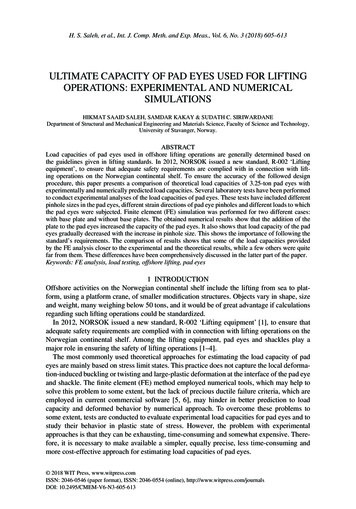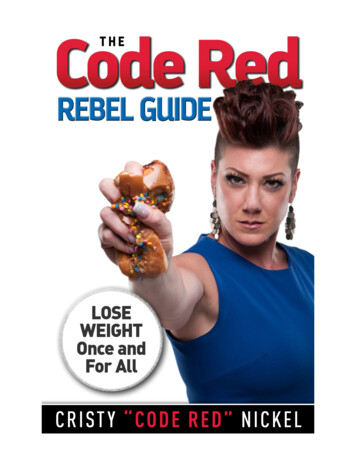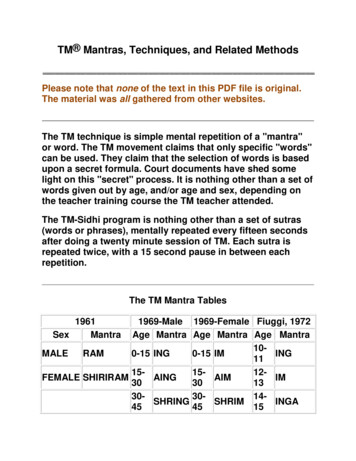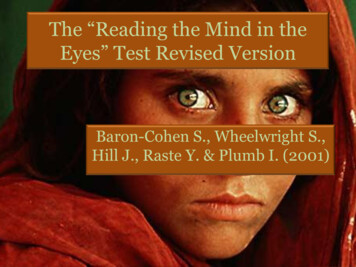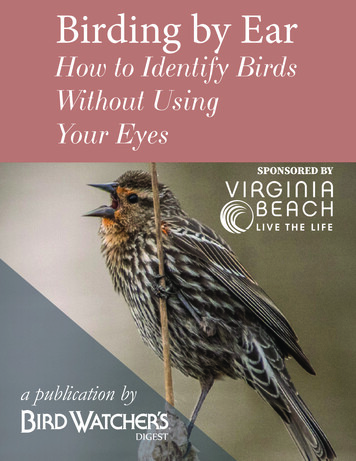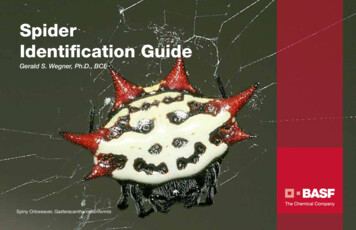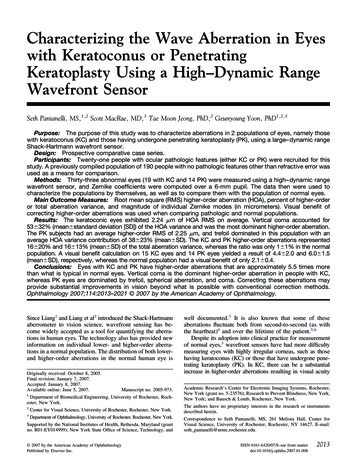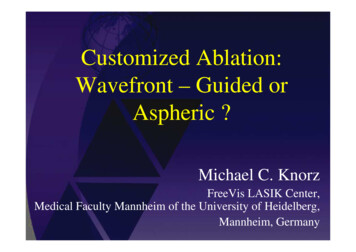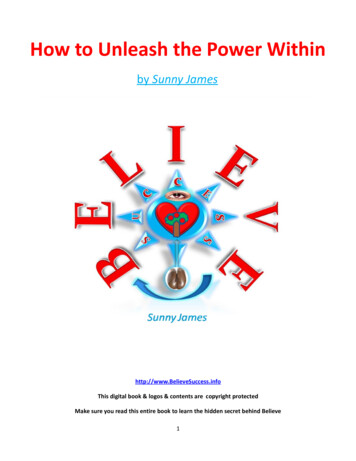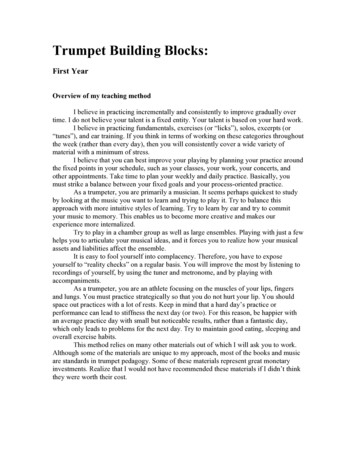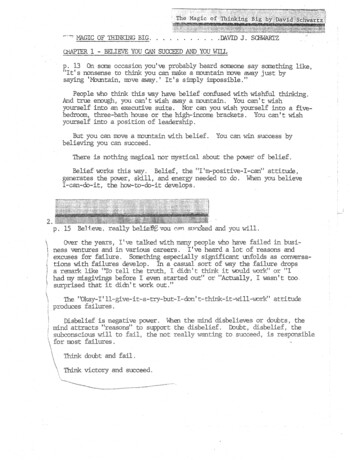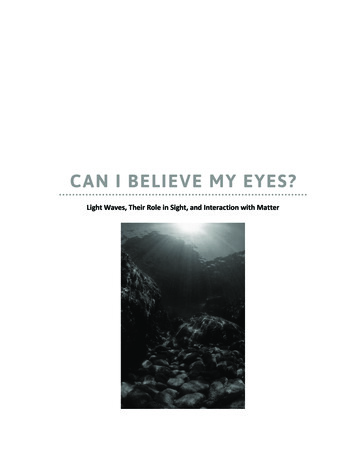
Transcription
CAN I BELIEVE MY EYES?Light Waves, Their Role in Sight, and Interaction with Matter
IQWST LEADERSHIP AND DEVELOPMENT TEAMJoseph S. Krajcik, Ph.D., Michigan State UniversityBrian J. Reiser, Ph.D., Northwestern UniversityLeeAnn M. Sutherland, Ph.D., University of MichiganDavid Fortus, Ph.D., Weizmann Institute of ScienceUnit LeadersStrand Leader: David Fortus, Ph.D., Weizmann Institute of ScienceDavid Grueber, Ph.D., Wayne State UniversityJeffrey Nordine, Ph.D., Trinity UniversityJeffrey Rozelle, Ph.D., Syracuse UniversityChristina V. Schwarz, Ph.D., Michigan State UniversityDana Vedder Weiss, Ph.D., Weizmann Institute of ScienceAyelet Weizman, Ph.D., Weizmann Institute of ScienceUnit ContributorLeeAnn M. Sutherland, Ph.D., University of MichiganUnit Pilot TeachersDan Keith, Williamston, MIKalonda Colson McDonald, Bates Academy, Detroit Public Schools, MIChristy Wonderly, Martin Middle School, MIUnit ReviewersVincent Lunetta, Ph.D., Penn State UniversitySofia Kesidou, Ph.D., Project 2061, American Association for the Advancement of Science
Investigating and Questioning Our Worldthrough Science and Technology(IQWST)CAN I BELIEVEM Y E Y E S?Light Waves, their Role in Sight, and their Interaction with MatterStudent EditionPhysical Science 1 (PS1)PS1 Eyes SE 3.0ISBN-13:978-1-940901-84-8
Physical Science 1 (PS1)Can I Believe My Eyes?Light Waves, their Role in Sight, and their Interaction with MatterISBN-13: 978-1-940901-84-8Copyright 2018 by Activate Learning. All rights reserved. No part of this book may be reproduced,by any means, without permission from the publisher. Requests for permission or information should beaddressed to Activate Learning, 44 Amogerone Crossway #7862 Greenwich, CT 06836About the PublisherActivate Learning is a mission-driven company that is passionate about STEM education. We make it easyfor teachers to teach with quality, investigation-centered science curriculum, tools, and technology. Formore information about what we do, please visit our website at http://www.activatelearning.com.IQWST (Investigating and Questioning Our World through Science and Technology)was developed with funding from the National Science Foundation grants 0101780 and0439352 awarded to the University of Michigan, and 0439493 awarded to NorthwesternUniversity. The ideas expressed herein are those of members of the development team andnot necessarily those of NSF.ArtEvery effort has been made to secure permission and provide appropriate credit for the photographicmaterials in this program. The publisher will correct any omission called to our attention in subsequent editions. We acknowledge the following people and institutions for the images in this book.Lesson 1Lesson 6Optical Illusion 2—Wikipedia, The FreeEncyclopediaHardwood Pores—Wikipedia, The FreeEncyclopediaLesson 3Lesson 13Solar Sail—National Aeronautics and SpaceAdministration, U.S. GovernmentSatellite Photograph of Earth—Courtesy NationalOceanic and Atmospheric Administration, U.S.Department of Commerce
PS1 ContentsLearning Set 1: How Does Light Allow Me to See?Lesson 1—Do You See What I See?1Lesson 2—What Do We Need to See an Object?9Lesson 3—Constructing Models of How People See21Lesson 4—The Eye as a Light Sensor33Lesson 5—How Are Shadows Created?43Learning Set 2: What Happens When Light Reaches an Object?Lesson 6—Scattering and Reflection of Light57Lesson 7—Transmission of Light73Lesson 8—Absorption of Light93Learning Set 3: How Can Light Have Different Colors?Lesson 9—What Is the Opposite of White Light?113Lesson 10—How Do Objects Change the Color of Light?127Lesson 11—Back to the Anchoring Activity137Learning Set 4: Is There Light I Cannot See?Lesson 12—Infrared Light and the Wave Model143Lesson 13—Ultraviolet Light and Nonvisible Light Imagery155AppendixAppendix Lesson 1—Ultraviolet Light and NonvisibleLight Imagery169Appendix Lesson 2—The Solar System185Appendix Lesson 3—The Earth-Sun-Moon System207
SCIENTIFIC PRINCIPLESA scientific principle states a scientific idea that is believed to be true based onevidence. As your class decides on new principles in this unit, add them to the list.
SCIENTIFIC PRINCIPLES
SCIENTIFIC PRINCIPLES
SCIENTIFIC PRINCIPLES
SCIENTIFIC PRINCIPLES
SCIENTIFIC PRINCIPLES
DRIVING QUESTION NOTESUse these sheets to organize and record ideas that will help youanswer the Driving Question or your own original questions.
DRIVING QUESTION NOTES
DRIVING QUESTION NOTES
DRIVING QUESTION NOTES
DRIVING QUESTION NOTES
DRIVING QUESTION NOTES
Activity 1.1—AnchoringActivity—Strange ImagesWhat Will We Do?We will observe two strange images. By the end of the unit, we will be able to explain howthese images work.Procedure a. Look at the first image your teacher projects. What do you see? Record your observations in the data table.b. Your teacher will project a second image. Which square appears darker to you, square Aor square B? Record what you see in the data table.c. Your teacher will make some changes to the second image. Which square appears darkernow, square A or square B? Record your observations.DataImageWhat I SeeFirst ImageSecond ImageSecond Image withAdditionsLESSON 1DO YOU SEE WHAT I SEE?1
Making Sense1. What did you notice about the circles in the first image?2. Do you think what happened was real? How do you know?2CAN I BELIEVE MY EYES?
3. Why do you think that square A and square B looked different the first time you lookedat them than they did the second time you looked at them?4. Asking and exploring the answers to questions is important to science. Does thisactivity make you think of any questions about light or about things you see? List yourquestions in the following space.LESSON 1DO YOU SEE WHAT I SEE?3
Lesson 1 Reading One—Look at This!Getting ReadyThe picture shows two bent rectangles. Which bentrectangle is longer?ANow use a ruler to measure the size of the two bentrectangles. Were you correct? To most people, B looksBlonger than A. When you measured, you might havelearned that your guess was wrong. In this reading, youwill learn how your brain can get confused by what youreyes see. You will be able to compare the figures in this reading to what you saw in class.To compare means to think about what is alike and what is different. As you read, think about whatis similar and different about the optical illusions you saw in class and the pictures in this reading.What Are Optical Illusions?Look at this picture.Stare at the small dot in the center of the circles. Now movethe picture closer to you while you keep looking at the dot.What happens?Tricks like these are called optical illusions. Optical is a wordrelated to your sense of sight. Many other words start with theprefix opt-. An optometrist is an eye doctor. If you need glasses,an optician may have helped you choose your glasses.You may have seen magicians who perform illusions.Magicians do not really make things disappear. But they do know how to fool your brain so youthink things disappear. Optical illusions can be fun because they fool you. Optical illusions area kind of trick. Your eyes play an important role in seeing. But your eyes and your brain worktogether. Your brain is the organ that makes sense of what you see. In the picture in the GettingReady section, your eyes see two identical bent rectangles. Your eyes see the right thing, butyour brain interprets it incorrectly. When your brain gets it wrong, this is called an illusion. Opticalillusions and magician’s tricks are not real. Your brain is just fooled.4CAN I BELIEVE MY EYES?
Another Optical IllusionLook at these small dark squares. If you look closely for afew seconds, you will see light gray circles in between thesquares. Are the gray circles really there, or do they justseem to be there?This is another example of an illusion. Your brain is beingfooled again.Can You Figure This Out?Here is one more interesting image. Look at the lines separating the rows of black and whitesquares.Do you think what you are seeing is an illusion? Arethe lines actually parallel and your brain is beingfooled, or are the lines really at angles?Were the Images in Class Optical Illusions?In class, you saw strange images. The first looked like a bunch of spinning circles. Thesecond image looked like a checkerboard with a square marked A being clearly darker thananother square marked B. Finally, your teacher added black rectangles to the second imageand it became apparent that squares A and B had actually identical darkness. These imagessucceeded in fooling your brain. They were illusions. You observed a real phenomenon. Whatyou saw depended on how your brain interpreted parts of the image. A phenomenon is an eventthat happens in the real world and that occurs over and over again.Sometimes you can observe things that appear very strange but are actually real. Hold the tipsof your thumb and index finger next to each other so that they are just about touching. Holdthem up so that they are next to your eye and look between them at a bright white background.You should just barely feel your thumb touching your finger. You should see one or more smallblack lines between your fingers. From where did these lines come? This is a real thing you areseeing, not an illusion. Your brain is not getting anything wrong. This goal in this unit is to figureout what happens to make people see things, whether they are real or illusions.LESSON 1DO YOU SEE WHAT I SEE?5
Investigating phenomena will help you learn how light affects what you see. In science class,you will observe different phenomena almost every day. By the end of the unit, you may be ableto explain the two optical illusions you saw in class.Observing the Two Illusions in ClassAn important part of science is making observations. An observation is the act of paying carefulattention to events that happen in the world. This is what you did in class. You paid close attentionto what you could see when you looked at the two images. Making good observations, pluslearning the science that goes with them, will help you to explain things that happen around you.What Questions Do You Have?List questions you have about light, seeing, or about the two images from class now thatyou have finished reading.Why Is Light Important?You already know that light helps you see. But did you know that if you understand the behaviorof light, you can also understand how cell phones and microwave ovens work? The scientificideas that explain the behavior of light also explain how computers, televisions, satellites, GPS,and many other systems work. In fact, many scientific discoveries from the last 100 years arebased on the same principles that explain the behavior of light. You will not study all of these inclass, but you will learn about many of them. You might also decide to investigate other uses oflight on your own. You may be surprised to learn that light plays an important role in just abouteverything around you.6CAN I BELIEVE MY EYES?
Activity 1.2—Driving Question BoardYour teacher will provide instructions for this space.LESSON 1DO YOU SEE WHAT I SEE?7
Activity 2.1—Probing Ideas:Seeing Objects around the RoomWhat Will We Do?We will explore some of the things humans need in order to see. We will try to explain why wecan see some objects but not others.Procedure a. Look at the image your teacher projects. Why can the girl see the tree? b. Look at the image your teacher projects. Why doesn’t the girl see the car?LESSON 2WHAT DO WE NEED TO SEE AN OBJECT?9
c. As your teacher names objects in the room, record them in the data table. Then put a checkmark ( ) in the appropriate column. You will not be able to see everything your teachernames. It is important that you keep your body and your eyes in the same position as youcollect data.Objects around the ClassroomObject10CAN I BELIEVE MY EYES?I CAN SeeI CANNOT See
Making Sense1. What factors affect whether you can see an object or not?LESSON 2WHAT DO WE NEED TO SEE AN OBJECT?11
Activity 2.2—Determining the Conditionsfor Sight—the Light BoxWhat Will We Do?We will gather evidence about what needs to happen in order for people to see an object.Procedure 1Follow your teacher’s directions. Record your observations from each step before you move onto the next step. a. Look into the light box. Be sure the lid and the flap remain closed. In the data table, drawwhat you see. b. Keep the light box lid closed. Open the side flap. Look into the light box. In the table, drawwhat you see.DataLight Box Activity ResultsFirst: Lid Closed and FlapClosedObservation12CAN I BELIEVE MY EYES?Second: Lid Closed andFlap Open
Making Sense1. Compare your observations.2. Why were your observations different?LESSON 2WHAT DO WE NEED TO SEE AN OBJECT?13
Procedure 2Your teacher will add a divider to your light box. Keep the box lid closed and the side flap open.Draw what you see in the following space. Include as much detail as you can.Making Sense1. Compare your drawing with other students’ drawings. How can you explain thedifferences?14CAN I BELIEVE MY EYES?
2. List the conditions that need to be met in order for people to see an object. This listshould be agreed upon by the whole class.3. Imagine that you look out the door of your science class just as a friend walks by andwaves to you. Explain how you can see your friend in the hall. Be sure to use all of theconditions you previously listed in your explanation.LESSON 2WHAT DO WE NEED TO SEE AN OBJECT?15
Lesson 2 Reading One—Picture This!Getting ReadyLook closely at the picture. Hold the paper close to your face. Now, set your book down and lookat the picture from across the room.Why do the small pictures you can see up close look likeone big picture from across the room?In this reading, you will learn how a similar idea makes the pictures that you see on TV.How Do People See Objects around Them?In class, you learned about things that affect what people see. You learned that the girl in theimage your teacher projected can see the tree because light travels from the sun, bounces offthe tree, and enters her eye.Image 116CAN I BELIEVE MY EYES?Image 2
In the second image your teacher projected, something different happens. Light from the sunbounces off the car, but this time the girl cannot see the car. Some of the light travels towardher, but it cannot enter her eye, because the wall blocks its path. If the light bouncing off the cardoes not enter her eye, the girl cannot see the car.Do you think the girl in Image 1 can see the sun? Why? (Be sure to write about the path thelight might take.)Do you think the girl in Image 2 can see the sun? Explain your ideas. (Be sure to write aboutthe path the light might take.)LESSON 2WHAT DO WE NEED TO SEE AN OBJECT?17
In Lesson 2, you looked for objects around the room. You learned that you could only seesome of the objects from your seat. You could not see other objects, even though some ofyour classmates could see them. You also looked into the end of a light box and learned thatsometimes you could see what was inside, and sometimes you could not.Your class used these activities to develop a list of conditions that need to be met in order forhumans to see an object. As you read, think about these conditions and how they affect whatyou see on a television.A Different Experience with Seeing: How Do I See Objects on Television?If you have a television in your home, turn it on. What do you see on the screen? You probablysee a person, some objects, or a scene indoors or outdoors. However, there is a differencebetween seeing the actual object and seeing the object on television. To see the object—like achair—in real life, you need a source to provide light, and you need the light to bounce off thechair to your eye. To see a chair on television, you do not need an additional source of light tobounce of the chair.The television is the light source. The television produces light that goes directly to your eyes.An image on television is both an object and a light source at the same time. That is why youcan see objects on television even in a room with no lights.Look at your activity sheet from Activity 2.2 to review your list of conditions people needto see. Explain what is different about seeing an object in a room and seeing an image ontelevision. Use the list of conditions in your explanation.18CAN I BELIEVE MY EYES?
How Is an Image on Television Similar tothe Picture at the Beginning of This Reading?When you see objects on television, you are really seeing many tiny dots. Together, the dotscreate an image that looks like something real. These dots are called pixels. On some televisions,especially old ones, you may be able to see the pixels if you look at the screen closely. Even ifyou can see the pixels up close, they are too small to be seen as individual dots when you standfar away. Instead, your brain will put them together to make an image. This is the same way thatthe picture in the Getting Ready section works. If you stand far enough away, the tiny pictureslook like pixels, and your brain puts them together to make a larger image.An Example of PixelsWhen you see an image on your television or on a movie screen, you are actually seeing millionsof tiny dots that all together look like the object or person. Your brain puts the dots together sothat you see a single image.Your television screen is a collection of tiny dots that join together to make the big picture yousee. Each little dot acts like a light source and an object. The light moves along a straight pathto your eyes. Your brain does not see a bunch of little objects, because it puts them together tosee the image on the television.Two More Examples:Newspapers and ArtworkDot patterns are not only used fortelevision images. Dots are also used incomputer and newspaper images andin paintings. If you have a newspaperat home, look at it very closely. If youhave a magnifying glass, use it to lookat the newspaper up close. Can you see the tiny dots that make up thepictures and the words? What do you notice in the photo of a flowerand in the closeup of the photo next to it?Many things in the world today use pixels to make images. Long ago, artists in France paintedin a style called pointillism. Images using pointillism are created by painting many tiny dotsor points. The colors of the paint are not mixed together using a brush. Instead, the differentcolored dots are placed very close together. When you look at the painting from far away, thelight from the room bounces off the dots on the painting and then enters your eye. Your brainblends the dots together to form a larger image.LESSON 2WHAT DO WE NEED TO SEE AN OBJECT?19
Compare the dots used in pointillism with the dots created on a television screen. Be surethat your comparison describes what is alike and what is different.Sunday Afternoon on the Island ofLa Grande Jatte, Georges Seurat20CAN I BELIEVE MY EYES?
Activity 3.1—Preparing to Develop ModelsWhat Will We Do?We will construct physical models of how people see. Our models will represent the keycomponents and relationships that we have learned so far.Part A: Evaluating a ModelA model can be good or not-so-good, depending on what it is being used for. When you use amodel to explain an idea to someone, the best model is usually a simple one. A good model forexplaining something includes all the key components and the relationships between them. Itis important that a model only includes those things and not extra parts that do not help explainsomething. It is also important that your model is accurate. You should look carefully at yourmodel to be sure you have represented the components and the relationships correctly. Yourteacher showed you a model of light using a clay light bulb and some toy cars.1. How can you use this model to explain how people see?LESSON 3CONSTRUCTING MODELS OF HOW PEOPLE SEE21
2. How could you improve this model of light? Think about the components and therelationships between them. For each part of the model, ask yourself if you couldexplain how people see without considering that component. Also ask yourself if thereis some part of seeing that your model does not represent.Part B: Plan Your Model3. A model needs to be consistent with all the evidence. In Lesson 2, you gatheredevidence that a model of seeing needs to include four key components: a light source,an object, an eye, and paths between the light, the object, and the eye. Look at thesupplies your teacher has provided. What will you use to represent each of these parts?22CAN I BELIEVE MY EYES?
Part C: Build and Evaluate Your Model4. No model is perfect. Every model has strengths and weaknesses. What are thestrengths and weaknesses of your model?5. What did you learn as you made your model of how people see an object?LESSON 3CONSTRUCTING MODELS OF HOW PEOPLE SEE23
Lesson 3 Reading One—ModelingGetting ReadyBefore you read about modeling, this short activity will get your brain working. First decidewhether you agree or disagree with the following statements. Then check the appropriate boxeson the left.As you read, try to learn the answers to these questions about scientific models. After you read,come back and check your answers.Why Do Scientists Use Models?When you hear the word model, you might think of fashion models ormodel airplanes or model cars. Scientists use the word model in a specialway. In science, a model is a way to represent an idea, process, or systemin order to describe, explain, or predict something.Models help to explain things that are difficult to understand or difficult toobserve. For instance, you cannot see your heart, but you can use a modelof a heart to explain how it pumps blood through your body. Models canalso represent things that are too big or too small to observe. People cannotobserve the whole Earth at once, but they can use maps and globes asmodels to help them explain phenomena. People on television use maps to help them explainweather or earthquakes. Globes can help explain why it is day and night at different times indifferent parts of the world.24CAN I BELIEVE MY EYES?
In class, you have been developing a model of how light makes it possible for people to seeobjects. Your model helps you understand, and it can also help you explain it to other people.Scientists use models to communicate. As you learn more about light, you might decide thatyou need a different model than the one you made today. Scientists revise their models as theylearn new things. It is OK if your model of how people see gets revised, too.Models help scientists think about possible answers to their questions about phenomena. Youwill use your model of seeing to explain how you could see the strange images in Lesson 1.Is It OK that My Friend’s Model Is Different from Mine?You and your classmates may have constructed different models of how people see.Different models can be helpful because they may show different information about the samephenomenon. All models have advantages and disadvantages. Even good models can oftenbe made better. You will be learning how to evaluate models to decide what is good and whatneeds to be changed.Scientists evaluate their own models and revise them when necessary. For example, new datamake scientists think about a phenomenon in a new way. Data is a word you will use over andover again in science. When scientists make observations, they take careful notes while theyare observing something with their senses or measuring it with instruments. The notes theywrite or record are called data. When they use data to support an idea, they are using the dataas evidence. You will do the same thing in science class. Your datamay come from your own observations and measurements, or itmay come from a table or graph that someone else made. Whenyou use data to explain an idea, you are using the data as evidence.When scientists—or you—develop a model, the model needs to beconsistent with all the relevant evidence.An Example of Scientists Revising TheirModelsScientists revise a model when it does not work very well forexplaining something. For example, you probably know that sailorsonce explored the world by sailing across oceans. They drew mapsof the oceans and land to show what the world looked like. Thesedrawings were similar to the flat maps we use today. Maps are onekind of model that is drawn. A flat model helped early scientistsunderstand most things about the world around them.However, as people made observations and tried to answer newquestions, they found that a flat model of Earth did not work foreverything. For example, sailors could see the tops of masts asLESSON 3CONSTRUCTING MODELS OF HOW PEOPLE SEE25
ships approached them over the horizon. If Earth was flat, that would not make sense. Theywould not see the tops of masts first and then gradually see the rest of the ship. They alsowondered why the sun changes its position in the sky throughout the year. A flat model of Earthwas not consistent with the data they observed.Scientists began to consider a new model. They began to use a round model of Earth—like a ball.A round Earth model can explain why the tops of ships’ masts are visible first. A globe modelcan explain the positions of the sun in the sky, and it can explain seasons.Later, photographs taken from space showed the shape of Earth. Before scientists knew forsure, they had to keep testing their model to see whether it worked to explain their observations.Today, a globe serves as a good model for many things scientists want to explain. A flat map isgood for showing how to get from one place to another. However, it is not good for explaininghow the sun rises and sets or how a ship can sail around the world. Every model has advantagesand disadvantages.A model that explains what you know today about how light helps people see might not be agood model for what you will try to explain later in the unit. You might revise your model as yougather more data. Scientists revise their models, and you can revise yours, too.Check Your UnderstandingGo back to the statements in the Getting Ready section. Now that you have finished reading, usethe column on the right to check whether you agree or disagree with each statement.26CAN I BELIEVE MY EYES?
Activity 3.2—Buildingthe Consensus ModelWhat Will We Do?We will combine the parts of our models that we agree about into one model called a consensusmodel. The consensus model will be a diagram instead of a physical model.Questions1. Models have advantages and they have disadvantages. What did you think were thebest parts of other students’ models? Why?2. How does your drawn model compare with the consensus model your class created?Describe what is similar and what is different about them.LESSON 3CONSTRUCTING MODELS OF HOW PEOPLE SEE27
3. Use your class consensus model to explain why you cannot see your grandma in theother room.4. What do you still need to know about how light helps you see? What do you still wantto know about how light helps you see?28CAN I BELIEVE MY EYES?
Lesson 3 Reading Two—Faster than a Speeding BulletGetting ReadyIn this reading, you will learn about how fast light moves. Before you read, think of some of thefastest things you have heard about. Fill in the chart with your ideas.Moving ObjectWhat/Who Is It?How Fast Does It Go?Fastest human runnerFastest bicycle riderFastest animalFastest carFastest man-made objectWhen people say that turning on a light switch lights up the room, whatdo they mean? In class, you constructed a model that shows what isneeded for people to see objects in a room. The key components in yourmodel were an object, an eye, a light source, and the key relationshipbetween these was the straight paths between them. When you turnon a light bulb, light travels from the bulb outward in all directions andhits objects in the room. You see the objects because light travelsfrom the light bulb, bounces off the objects, and then enters your eye.If light has to travel back and forth across the room before you can see an object, why do yousee things in a room as soon as you turn on a light switch? The answer has to do with the speedof light. Light is very fast. You will read about how scientists figured out how fast light is.LESSON 3CONSTRUCTING MODELS OF HOW PEOPLE SEE29
How Do Scientists Measure How Fast Light Moves?You do not have to wait to see things after you turn on a light, because light moves so fast.You do not even notice light moving. It probably seems like light gets from a bulb to an objectand back to your eye instantly. If light moves so fast, how can scientists measure it? A famousscientist, Galileo, tried to measure how fast light moves.Galileo wanted to measure the speed of light in the early 1600s. To do this, he sent an assistantto the top of a hill with a lamp. He wanted to measure how much time it took for light to travelfrom one hilltop to another. The assistant recorded what time it was on his timepiece as he turnedon his light. Galileo, standing on another hill, turned on his light immediately after he saw hisassistant’s light. The assistant then recorded the time at the instant he saw Galileo’s light. Galileo’sidea was that the assistant would have measured the time it took light to travel from one hill tothe other and then back again. However, this did not work. The time it took Galileo to turn on hislight was actually much longer than the time it took the light to travel from one hill to the next.When Galileo first tried to measure the speed of light, he and his assistant stood on hilltopswith lamps. Why was it necessary for them to be standing on the top of hills to conducttheir experiment? (Think about the four conditions needed to see an object.)30CAN I BELIEVE MY EYES?
Using the consensus model you and your classmates constru
But your eyes and your brain work together. Your brain is the organ that makes sense of what you see. In the picture in the Getting Ready section, your eyes see two identical bent rectangles. Your eyes see the right thing, but your brain interprets it incorrectly. When your brain
